Synergis: From the decentralized telecom operator Roams user base reaching one million, analyzing the possibility of sub

Driven by the global information wave, the traditional business model of the telecommunications industry is facing unprecedented challenges. On the one hand, the initial investment pressure brought by 5G continues to increase. On the other hand, due to the delay in the transformation of its revenue model, value-added services have not seen any improvement so far. Traditional user communication service fee income continues to decline under the pressure of peer competition. As shown in the following figure, among the leading companies listed in the United States, although the revenue of the telecommunications service industry is 50% higher than that of Internet giants, its profitability is only 30% of the latter. The profit margin of the telecommunications industry is only 20% of that of Internet giants, and the net income is only maintained at around 5%. Compared with Internet companies, the market value of telecommunications operators is only 30% of that of them, which shows that investors have a serious lack of confidence in the model of heavy asset investment and low growth potential.

Limitations of the traditional telecom operator model
The traditional telecommunications company model relies on users signing long-term contracts and paying fixed fees to obtain network access. This so-called pay-for-use model is quite inefficient in todays digital age. Users can usually only choose one service provider, such as ATT, Verizon or T-Mobile, and cannot switch freely or enjoy multiple services at the same time. This limitation not only divides the user base, but also ignores the user experience and makes it difficult to attract new customers.
In stark contrast, Internet services such as search, social networking, and e-commerce are almost all free and open to users. It is hard to imagine how limited and small-scale applications would be if Google and Bing each served half of their fixed customers in the United States, or if Alibaba, Baidu, and Tencent each served only one-third of their fixed customers in China. Operators are increasingly reduced to the role of channels. Although the entire Internet traffic flows through their infrastructure, they are separated from the most valuable services.
To get rid of the channel dilemma, telecom operators must shift from paid access to free access to cover all consumers and improve their network effects, thereby providing high-value services directly to users instead of charging limited fixed channel fees. However, this transformation is a huge challenge for large and bureaucratic telecom companies.
The innovative model and implementation of decentralized telecom operator Roam
We have noticed that in this transformation, Roam has rapidly risen through its innovative free-to-use model and has become an industry challenger that combines Web3 technology with telecommunications services. In the past year, Roam has achieved amazing growth in the number of users and nodes without a large amount of marketing investment, with the number of users exceeding one million, winning the attention and support of a large number of traditional operators and becoming a leading project in the decentralized physical infrastructure (DePIN) track. As shown in the figure below, Roam ranks second in the DEPIN data analysis website depinscan.io.
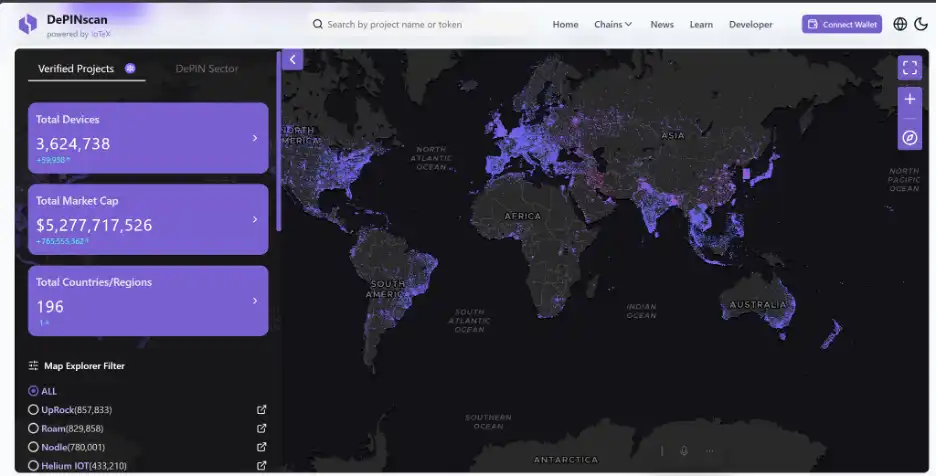
In-depth analysis of how Roam uses communication technology and decentralized models to create a new telecom operator model
Roam is the only decentralized communication network built by upgrading OpenRoaming
Globally, WiFi and mobile networks are the two mainstays of wireless broadband access. Almost all mobile interactions rely on these two. Because WiFi is usually free to use, it carries more than 70% of data traffic (as shown in the figure below). In the 5G era, the trend of WiFi and mobile network integration is becoming increasingly obvious. Due to the insufficient deployment density of 5G networks, high power consumption of base stations and high operating costs, operators tend to use WiFi networks to share traffic in order to reduce operating costs. However, this also means that the old WiFi network is no longer competent, and a comprehensive upgrade of WiFi is imperative. This includes upgrading from WiFi 4 and WiFi 5 to the new communication protocols WiFi 6 and WiFi 7 (it is worth mentioning that Roams self-developed WiFi routers are the first batch of home routers that support WiFi 6 protocols), as well as changing from traditional username/password login and Captive Portal web login to automatic login based on Passpoint and OpenRoaming security certificates. According to a market analysis report by 市场 and Markets, the relevant market is expected to grow fourfold in the next five years.
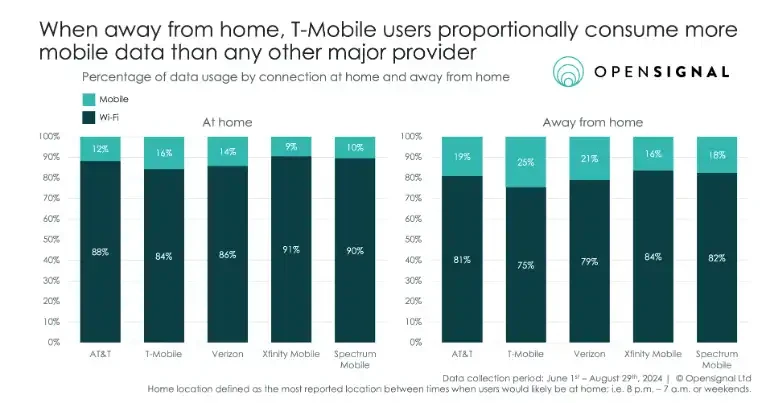
Roam cooperates with the WiFi Alliance and the World Wireless Broadband Alliance (WBA) to support the access transformation of OpenRoaming. The OpenRoaming network is a qualitative leap compared to ordinary public WiFi. Ordinary public WiFi users often need to log in through a web page. In this case, the login process is not automatic, and their communications are often unencrypted. The OpenRoaming network WiFi automatically logs in like a mobile cellular network, and the communication is securely encrypted throughout the process. This strategic cooperation enables Roam to provide unified network access services worldwide. Users do not need to repeatedly log in to different networks, and can achieve truly seamless roaming between celluar and WiFi. Through this cooperation, Roam has not only expanded its network coverage (there are more than 4 million OpenRoaming WiFi hotspots worldwide), but also significantly improved the user experience and met the users high demand for convenience and continuity.
New telecom operation business model: driving decentralized network construction with free user access
The key reason why Roam can attract a large number of users is that it breaks the entry barriers of traditional telecommunications and provides free wireless network access. With the trend of global WiFi network upgrades and the support of industry standard organizations, Roam attracts users to participate in the upgrade of the OpenRoaming network. Participants can not only upgrade to safer and more convenient WiFi, but also get free global eSIM traffic as an incentive. This method allows users to access the network for free whether through WiFi or mobile phone eSIM. In addition, users can also obtain Roam points through network co-construction and other methods to redeem goods and services. In addition, Roam uses hardware network nodes (such as Rainier MAX 60 routers) to share CDN bandwidth, etc., and users can also get additional incentives from it. By participating in the construction and verification of the OpenRoaming network, users can get free global traffic rewards that can be used in 200 countries. This new model not only greatly reduces the cost of network use, but also allows users to deeply participate in the revenue sharing of the operating network, thus forming a business closed loop that encourages users to further invest in network construction.
This incentive mechanism not only improves user engagement, but also helps Roam quickly establish an active user community. Currently, more than 600,000 users participate in network quality verification and feedback every day. This high-frequency usage scenario is difficult to achieve in the applications of traditional operators. Roam has found a development direction that is no longer a simple channel, but a network service co-construction community that benefits users and related businesses. At the same time, Roam also attaches importance to the communication between the community and the operation team, and users have contributed a lot of suggestions for network improvements. We participated in an AMA event on App design and found that in just one hour, community members put forward more than 300 App improvement suggestions. This community-driven model enables Roam to respond quickly to market needs and user expectations and maintain a competitive advantage in the industry. The active participation of users not only promotes network optimization, but also enhances user loyalty and brand stickiness.
Technical foundation: Web3 and blockchain
In addition to using telecommunications technologies such as OpenRoaming, the Roam telecommunications network also relies on the support of Web3 technology. The decentralized nature of blockchain provides security for data transmission and storage, ensuring the privacy and security of user data. MetaBlox Labs Inc. behind Roam has become one of the top ten root identity issuers of OpenRoaming in the world (the only 网络3 company), on par with Cisco. Unlike other issuers, Roam has innovatively developed an OpenRoaming upgrade solution based on the W3C decentralized digital identity standard to address the difficulty of implementing OpenRoaming in small and medium-sized businesses, effectively solving the technical and cost barriers in implementation.
In addition, Roam also allows non-WiFi operators (such as credit card issuers, game publishers, schools, etc.) to easily integrate the OpenRoaming framework based on decentralized digital identity, helping their users enjoy safe and free WiFi roaming at no cost. This approach not only expands the application scenarios of OpenRoaming, but also expands the influence of Roam, allowing more users to experience convenient network access services.
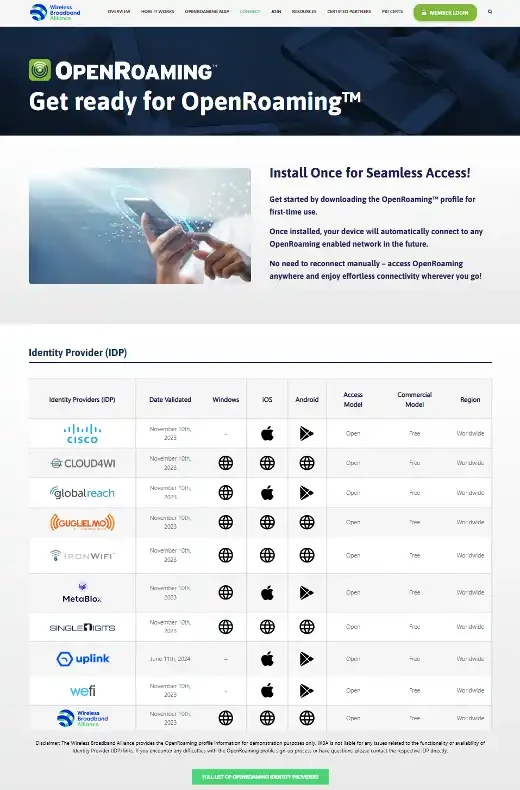
Roam is expected to become the first WEB3 telecommunications network to be widely adopted
In less than a year, Roam has rapidly grown to over one million users, covering nearly 200 countries and regions around the world, despite the fact that the WEB3 industry was only known and accepted by the whole society. It has over 820,000 self-owned nodes, and even sparsely populated areas such as the Siberian Plateau, northern Canada, and Alaska have Roam network nodes.
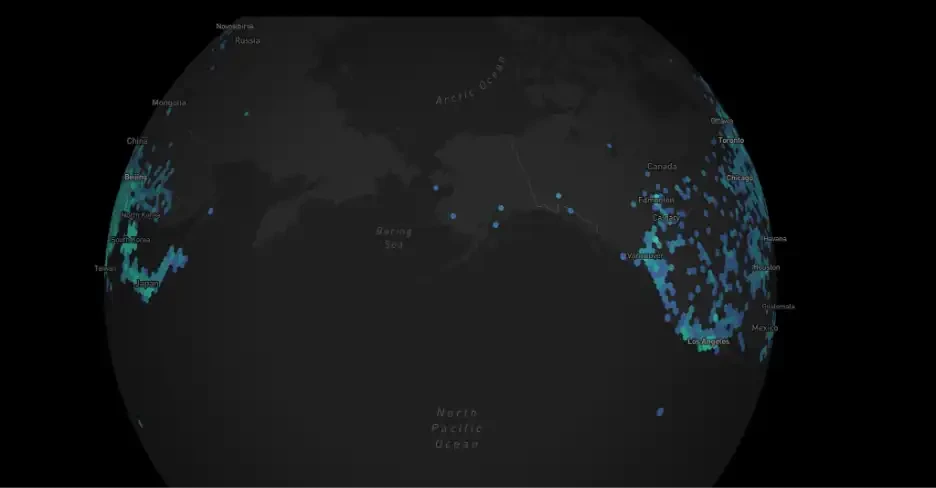
It is not difficult for users to find that by participating in the card verification of the Roam network, they can get 1-2 GB of free global eSim traffic every month. If the traffic is not enough, the price of further purchase is also very competitive. In the traditional world, when users change countries or regions, the remaining eSIM traffic often expires, while Roams traffic will automatically be converted to local traffic. This can significantly reduce monthly communication costs for people who travel abroad frequently. Therefore, Roam has the opportunity to soon become the preferred provider of travel traffic for travelers.
Further comparison shows that Roam has the potential to become the main traffic provider for users local life. According to statistics from Statista (left picture below) and OECD (right picture below), the average American currently spends about $30 per month and consumes about 10G of traffic. When Roam users participate in the construction of OpenRoaming in non-roaming situations, their monthly wireless access costs may be reduced by 50% or more. In addition to cost savings, Roams community-driven model greatly enhances user stickiness and creates new operating revenue opportunities.
This real and effective application is expected to become the core product that uses blockchain and Web3 technology to change peoples lives.
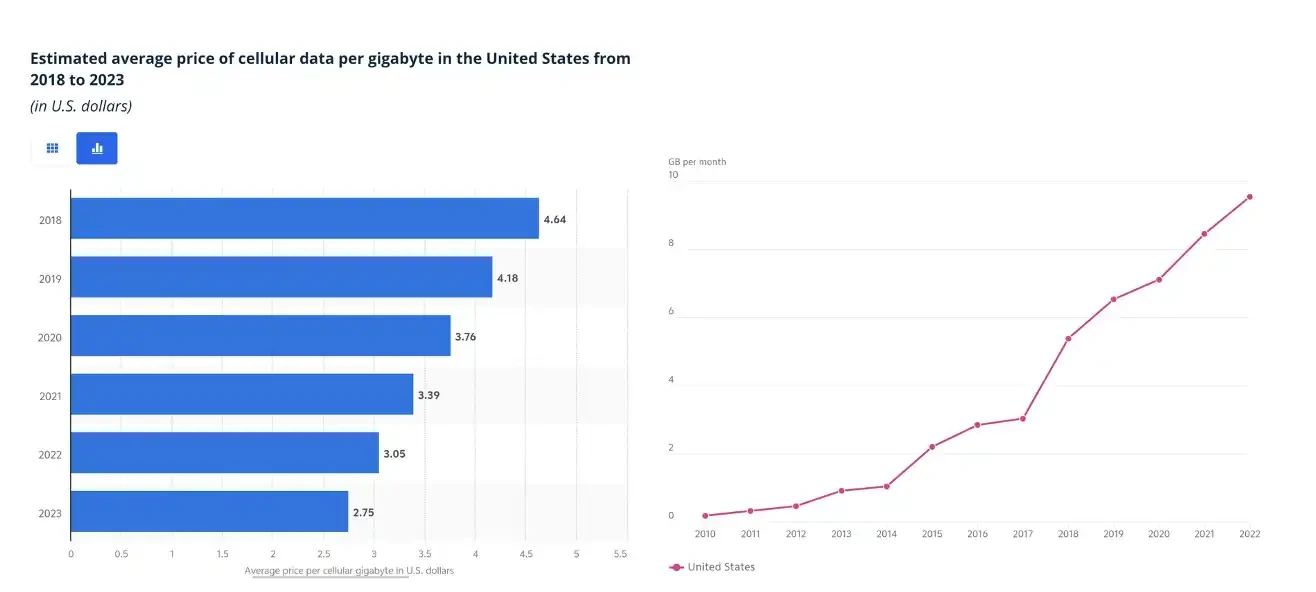
With the continuous development of communication and artificial intelligence technologies, WiFi OpenRoaming technology based on security certificates is expected to expand to more application scenarios. Especially in the field of smart home, it can optimize the security and seamless access of devices and support the integration of AI agents in smart homes. This not only improves the user experience, but also provides strong technical support for smart life. Roam also shows great potential in this context.
Looking ahead to the next five years, I hope Roam can delve deeper into more industries and application scenarios, from individual users to corporate needs, and establish itself as a bridge connecting everything, achieving seamless integration of users, devices and AI, and promoting true intelligent connectivity.
Through various efforts, Roam is re定义ning the new business model of the telecommunications industry and bringing users a richer network experience. It is not only a typical example of how Web3 changes the industry landscape, but also an important 指导 for the future development of the telecommunications industry.
免责声明
This article is only for sharing case analysis of the companies we invest in, and is intended to provide in-depth research and understanding of the business model, technology foundation, etc. of the company. Although we believe that the information provided is reliable, we do not make any claims as to its enduring accuracy or suitability for specific circumstances. Therefore, you should not make investment decisions based solely on the content of this article.
Any forecasts, estimates, targets, prospects and/or opinions expressed in this article are subject to change at any time and may differ or contradict opinions expressed by other sources or individuals. The contents of this article are for informational purposes only and should not be relied upon as the basis for investment decisions and should not be assumed to be complete. You should not regard the contents of this article as legal, business or tax advice of any nature and please consult your professional advisor on relevant matters. This article does not constitute investment advice or an offer to provide investment advisory services. There is no guarantee that any investment target mentioned, referenced or described in this article will be profitable or that other investments in the future will necessarily have similar characteristics and results.
A detailed list of investments made in funds managed by Synergis Capital can be found 这里 . Please note that this list does not include investments that have not yet been announced. This article does not constitute investment advice or an offer to sell, nor does it constitute a solicitation to purchase any interest in any investment vehicle managed by Synergis Capital. Any offer or solicitation of investment in any Synergis Capital investment vehicle is made only on the basis of a private placement memorandum or related legal documents, and decisions should be made solely on the basis of the information contained in these official documents.
This article is from a contribution and does not represent the views of BlockBeats
This article is sourced from the internet: Synergis: From the decentralized telecom operator Roams user base reaching one million, analyzing the possibility of subverting the traditional telecom business model
As of November 24, the statistics of BTC, ETH, and TON on the TrendX platform are as follows: The number of BTC discussions last week was 19.39K, up 10.69% from the previous week; the price last Sunday was $98,432, up 7% from the previous Sunday. ETH had 4.7K discussions last week, up 13.89% from the previous week; the price last Sunday was $3,489, up 11.3% from the previous Sunday. TON had 782 discussions last week, up 3.44% from the previous week; the price last Sunday was $5.52, up 11.5% from the previous Sunday. Binance founder CZ and Ethereum founder Vitalik appeared together at a gathering of the decentralized science project Bio Protocol, expressing their support for Desci. CZ also said that he hopes to see 1,000 Desci projects next year,…







